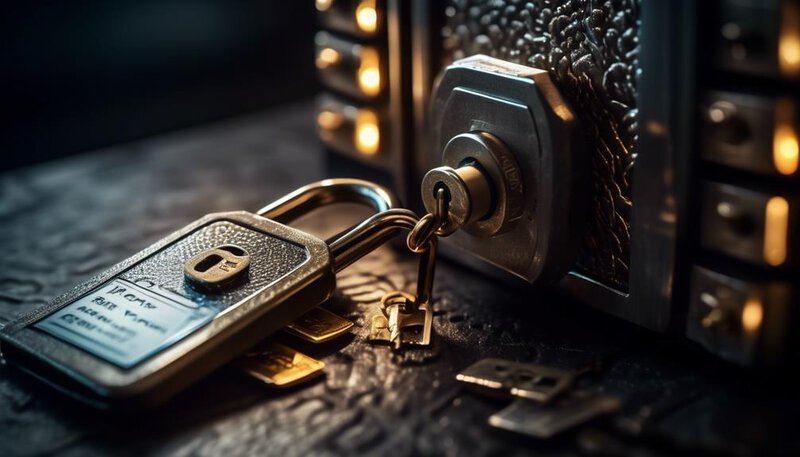Why Multi-Factor Authentication Is a Must for VPN Users

Multi-factor authentication is an essential layer of protection for VPN users. It adds an extra level of security to ensure that only authorized individuals can access their online activities.
By requiring users to provide multiple pieces of evidence to verify their identities, such as a password, a fingerprint scan, or a one-time verification code, multi-factor authentication significantly reduces the risk of unauthorized access.
This additional layer of security is particularly important for VPN users because VPNs are often used to access sensitive information or conduct transactions online. Without multi-factor authentication, a stolen or easily guessable password could be enough for an attacker to gain access to a user's VPN account and potentially compromise their data.
In addition to protecting against unauthorized access, multi-factor authentication also helps users detect and mitigate account breaches. If a user receives a verification code or authentication request that they did not initiate, it could be an indication that someone else is trying to access their account. By alerting the user to this suspicious activity, multi-factor authentication allows them to take immediate action, such as changing their password or contacting their VPN provider.
Overall, multi-factor authentication is a crucial security measure for VPN users. It provides an additional layer of protection, reduces the risk of unauthorized access, and helps users detect and respond to potential breaches. By implementing multi-factor authentication, VPN users can significantly enhance the security of their online activities.
Key Takeaways
- Multi-Factor Authentication adds an extra layer of security for VPN users, protecting their online activities and reducing the risk of unauthorized access.
- Implementing Multi-Factor Authentication helps detect and mitigate account breaches, making it crucial for VPN users accessing sensitive information or conducting transactions.
- Multi-Factor Authentication enhances the overall security of online activities by requiring multiple forms of identification before granting access to sensitive information, preventing unauthorized access to VPN networks.
- Using Multi-Factor Authentication significantly increases the difficulty for attackers to infiltrate the system, providing enhanced security measures against common attacks like password breaches and phishing attempts.
The Growing Importance of Multi-Factor Authentication
The growing importance of multi-factor authentication lies in its ability to provide enhanced security measures for VPN users. In today's digital landscape, where cyber threats are abundant, it becomes crucial to understand the importance of implementing robust authentication methods. Multi-factor authentication offers an additional layer of protection by requiring users to provide multiple forms of identification before granting access to sensitive information.
One of the key benefits of multi-factor authentication is its ability to prevent unauthorized access to VPN networks. By combining something the user knows (like a password), something they've (like a mobile device), and something they're (like a fingerprint), multi-factor authentication significantly reduces the risk of unauthorized individuals gaining access to sensitive data.
Moreover, multi-factor authentication adds an extra level of security against common attacks such as password breaches and phishing attempts. Even if an attacker manages to obtain a user's password, they'd still need to bypass the additional authentication factors, making it significantly harder for them to infiltrate the system.
Understanding the Risks of VPN Usage
What are the risks associated with using VPNs? Understanding the importance of privacy and the security implications of VPN usage is crucial for anyone seeking freedom online. While VPNs offer many benefits, they also come with certain risks that users need to be aware of.
One of the main risks of using a VPN is the potential for data breaches. Although VPNs encrypt your internet traffic, there is still a possibility for hackers to gain access to your sensitive information. Additionally, using a VPN can give a false sense of security, leading users to engage in risky online behavior.
Another risk is the trustworthiness of VPN service providers. Not all VPN providers are created equal, and some may have questionable privacy policies or even sell user data to third parties. It's important to thoroughly research and choose a reputable VPN provider to mitigate this risk.
To help you understand the risks associated with VPN usage, consider the following table:
| Risks | Implications |
|---|---|
| Data breaches | Potential exposure of sensitive information |
| False sense of security | Encourages risky online behavior |
| Untrustworthy VPN providers | Privacy concerns and potential data sharing |
How Multi-Factor Authentication Works
Multi-Factor Authentication (MFA) works by adding an extra layer of security to the login process. It requires users to provide multiple forms of identification, such as a password, a fingerprint, or a one-time code, before gaining access to their accounts.
This additional authentication layer greatly enhances the protection of user accounts and helps prevent unauthorized access.
Secure Login Process
To enhance the security of the login process, consider incorporating multi-factor authentication, which adds an extra layer of protection by requiring users to provide multiple forms of verification. This secure login process ensures that only authorized individuals gain access to your VPN. Multi-factor authentication typically involves three factors: something you know (such as a password or PIN), something you have (such as a smartphone or token), and something you are (such as a fingerprint or facial recognition). By combining these factors, the likelihood of unauthorized access is greatly reduced. To illustrate this concept, consider the following table:
| Factor | Description |
|---|---|
| Something you know | A password or PIN code that only you should know. |
| Something you have | A physical device, like a smartphone or token, that you possess. |
| Something you are | A unique biometric characteristic, such as a fingerprint or facial recognition. |
Additional Authentication Layer
To further safeguard the login process, incorporating an additional authentication layer is crucial in order to provide a higher level of security for VPN users. By implementing multi-factor authentication (MFA), you can add an extra layer of protection to your VPN login. MFA requires users to provide multiple forms of identification, making it significantly harder for unauthorized individuals to gain access to your VPN account.
Here are three ways multi-factor authentication enhances security:
- One-time passwords (OTP): This involves generating a unique password that's only valid for a limited time. It adds an extra step to the login process, ensuring that even if your regular password is compromised, the attacker won't be able to access your VPN without the OTP.
- Biometric authentication: By using fingerprints, facial recognition, or other biometric data, this method adds an additional layer of security that's unique to you.
- Hardware tokens: These physical devices generate one-time passwords that are required for login, providing an extra level of security beyond regular passwords.
Enhanced Account Protection
Implementing multi-factor authentication enhances account protection by requiring users to provide multiple forms of identification, adding an extra layer of security to the login process.
This method of authentication goes beyond the traditional username and password combination, which can be easily compromised. With multi-factor authentication, users are typically required to provide something they know (such as a password), something they have (such as a unique code sent to their mobile device), and sometimes something they are (such as a fingerprint or facial recognition).
By combining two or more of these factors, the likelihood of unauthorized access is greatly reduced. This is especially important for VPN users, as they often deal with sensitive information and need to ensure their account security.
Two-factor authentication is a simple yet effective way to protect your VPN account and maintain your freedom online.
Benefits of Multi-Factor Authentication for VPN Users
Using multi-factor authentication for VPN users enhances security and safeguards against unauthorized access. Implementing this additional layer of protection offers several benefits that contribute to improving privacy and reducing cybersecurity risks.
Benefits of multi-factor authentication for VPN users include:
- Enhanced account security: Multi-factor authentication adds an extra layer of security by requiring users to provide multiple forms of identification, such as a password and a unique code sent to their mobile device. This significantly reduces the likelihood of unauthorized individuals gaining access to the VPN account.
- Protection against password breaches: With the rising number of data breaches and password leaks, relying solely on a password for authentication can leave your VPN account vulnerable. Multi-factor authentication adds an extra level of security, making it more difficult for attackers to gain access even if your password is compromised.
- Secure remote access: Multi-factor authentication ensures that only authorized individuals can access the VPN remotely. By requiring an additional authentication factor, such as a fingerprint or a token, it adds an extra layer of security to prevent unauthorized access from any location.
Implementing Multi-Factor Authentication: Best Practices
When implementing multi-factor authentication for VPN users, there are several best practices to consider.
First, you need to carefully choose the methods for implementation, such as using a combination of something the user knows (like a password) and something the user has (like a fingerprint). This helps to ensure a higher level of security for your VPN.
Additionally, it's important to consider the user experience when implementing multi-factor authentication, as it should be seamless and easy for users to follow without causing frustration or delays in accessing the VPN.
Methods for Implementation
To effectively implement multi-factor authentication for VPN users, it's recommended to carefully consider the methods for implementation and adhere to best practices. Here are three key methods to consider:
- Use a combination of factors: Incorporate multiple authentication factors, such as something the user knows (password), something the user has (smartphone), and something the user is (biometric data). This multi-layered approach provides an extra layer of security and makes it harder for attackers to gain unauthorized access.
- Implement a strong password policy: Enforce password complexity requirements, regular password changes, and discourage the use of common or easily guessable passwords. Additionally, consider implementing password managers or passwordless authentication methods for added convenience and security.
- Utilize adaptive authentication: Implement adaptive authentication solutions that analyze user behavior and context to assess the risk level. This allows for a more dynamic authentication process, where additional factors are required based on the perceived risk of the user's actions.
Security Benefits
As you explore the security benefits of implementing multi-factor authentication best practices, you'll discover the enhanced protection it offers against unauthorized access attempts.
Multi-factor authentication adds an extra layer of security to your VPN connection by requiring multiple forms of verification. This mitigates the risk of unauthorized users gaining access to your sensitive data or network resources.
By implementing multi-factor authentication, you strengthen your security measures and reduce the likelihood of successful attacks. In addition, multi-factor authentication protocols such as SMS verification codes, biometric authentication, or hardware tokens provide a higher level of assurance of the user's identity.
This ensures that only authorized individuals can access your VPN, protecting your data from potential threats. By adopting multi-factor authentication, you can enjoy greater peace of mind and a higher level of security for your VPN usage.
User Experience Considerations
Consider these user experience considerations when implementing multi-factor authentication best practices:
- Simplify the authentication process: Implement a user-friendly interface that allows users to easily complete the authentication steps. Streamlining the process will reduce frustration and save time.
- Offer multiple authentication methods: Provide users with a variety of authentication options, such as SMS codes, fingerprint recognition, or hardware tokens. This allows users to choose the method that best suits their preferences and devices.
- Balance security and productivity: While multi-factor authentication enhances security, it can also impact productivity. Strive to find a balance that ensures strong authentication without significantly slowing down the user experience. Consider factors such as the frequency of authentication prompts and the ease of completing the process.
Choosing the Right Multi-Factor Authentication Methods
One effective approach for selecting the appropriate multi-factor authentication methods is to conduct a thorough evaluation of their compatibility with your organization's security requirements and user needs. When evaluating effectiveness, consider the strength of each authentication factor and how they can complement each other. Look for methods that provide a high level of security without sacrificing convenience. User acceptance is also crucial, as it determines how willing users are to adopt and consistently use the chosen authentication methods.
Start by assessing the various authentication factors available, such as something you know (passwords), something you have (tokens or smart cards), and something you're (biometrics). Consider the strengths and weaknesses of each factor and how they align with your organization's security policies. For example, biometrics may offer strong security, but some users may be hesitant to provide their biometric data.
Additionally, consider the user experience of each authentication method. Will it introduce friction or complexity for users? Will it require additional hardware or software installations? Ideally, the chosen methods should be easy to use and seamlessly integrate into existing workflows.
To ensure a successful implementation, involve key stakeholders, such as IT administrators and end-users, in the evaluation process. Their input and feedback will help identify the most suitable multi-factor authentication methods for your organization. Remember, choosing the right methods is crucial in striking the balance between security and usability.
Enhancing Security With Multi-Factor Authentication for VPNs
To enhance the security of your VPN, implement multi-factor authentication methods. By adding an extra layer of protection, you can ensure that only authorized individuals have access to your network.
Here are three effective methods for implementing multi-factor authentication:
- One-Time Passwords (OTP): With OTP, users receive a unique code via SMS or email that they must enter along with their username and password. This method provides an additional level of security by requiring a code that's valid for a single login session only.
- Biometric Authentication: This method uses unique physical or behavioral characteristics, such as fingerprints or facial recognition, to verify a user's identity. Biometric authentication adds an extra layer of security, making it difficult for unauthorized individuals to access your VPN.
- Hardware Tokens: Hardware tokens are physical devices that generate a unique code that must be entered during the login process. These tokens can be carried on a keychain or stored in a USB device, providing an additional layer of security by requiring the physical presence of the token.
When choosing the right multi-factor authentication methods for your VPN, consider factors such as ease of use, level of security, and compatibility with your existing infrastructure.
Implementing multi-factor authentication will significantly enhance the security of your VPN, providing peace of mind for you and your organization.
Frequently Asked Questions
What Are Some Common Vulnerabilities in VPN Usage That Multi-Factor Authentication Can Help Mitigate?
Using multi-factor authentication with VPNs can help mitigate common vulnerabilities in VPN usage such as weak passwords and stolen credentials. It adds an extra layer of security, ensuring only authorized users can access the network.
Can Multi-Factor Authentication Be Used With Any Type of VPN, or Are There Specific Requirements?
Multi-factor authentication offers advantages when used with VPNs, but compatibility with specific VPN protocols may vary. It provides an extra layer of security, ensuring that only authorized users can access the virtual private network.
Are There Any Downsides or Disadvantages to Using Multi-Factor Authentication for VPN Users?
Using multi-factor authentication for VPN users may have downsides or disadvantages. It can add complexity to the login process and potentially cause user frustration. However, the added security outweighs these drawbacks.
How Does Multi-Factor Authentication Work in Conjunction With Other Security Measures, Such as Encryption?
When using multi-factor authentication with encryption in VPN usage, you benefit from increased security and protection against unauthorized access. However, it's important to note that multi-factor authentication has limitations in fully securing VPN connections.
What Are Some Best Practices for Implementing and Managing Multi-Factor Authentication for VPN Users?
Implementing multi-factor authentication for VPN users requires following best practices such as choosing strong authentication methods, regularly updating and monitoring the system, and conducting user training to emphasize the importance of security.








